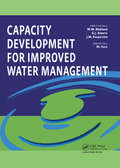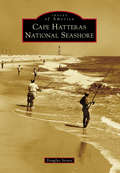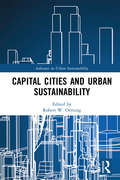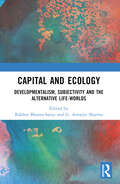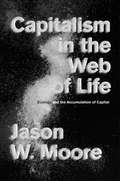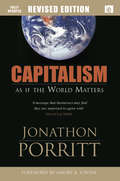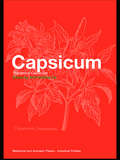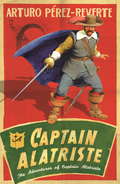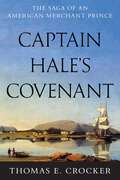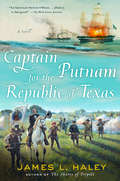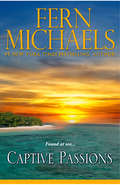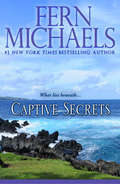- Table View
- List View
Canyoneering: A Guide to Techniques for Wet and Dry Canyons (How To Climb Series)
by David BlackIn David Black&’s Canyoneering: A Guide to Techniques for Wet and Dry Canyons, readers learn the hazards and risks of canyoneering, the skills required to gain mastery of canyoneering style and technique, and simple, effective ways to negotiate hazardous terrain. This completed updated, thorough, and to-the-point guide will provide easily understood descriptions of skills used by leading-edge canyoneers and promote simple techniques for solving complex problems. The purpose of this book is to equip canyoneers at all levels with the technical skills they need to enjoy a clean canyoneering experience and avoid dangerous mistakes. This full-color book is the only guide endorsed by the American Canyoneering Association.Includes information on:The right way to apply climbing, caving, and whitewater skills to technical canyoneeringAn explanation of technical canyon ratingsSimple, effective ways to negotiate hazardous terrainTwelve classic canyons in North America and their ratingsACA-certified instructors, guides, and guide service
Capabilities-Based Planning for Energy Security at Department of Defense Installations
by Henry H. Willis Constantine SamarasDepartment of Defense (DoD) installations rely on the commercial electricity grid for 99 percent of their electricity needs, but the U. S. electricity grid is vulnerable to disruption from natural hazards and actor-induced outages, such as physical or cyber attacks. Using portfolio analysis methods for assessing capability options, this paper presents a framework to evaluate choices among energy security strategies for DoD installations.
Capacity Development for Improved Water Management
by M.W. Blokland, G.J. Alaerts, J.M. Kaspersma and M. HareThis collection of papers explains how knowledge and capacity development can contribute to improved, effective water management with a digest of lessons learned in the areas of development of tools and techniques, field applications and evaluation. The authors are prominent practitioners, capacity builders and academics within the water and capacity development sectors.Capacity Development for Improved Water Management starts with an introduction and overview of progress and challenges in knowledge and capacity development in the water sector. The next part presents tools and techniques that are being used in knowledge and capacity development in response to the prevailing challenges in the water sector, and a review of experience with capacity change in other sectors. In the third part a number of cases are presented that cover knowledge and capacity development experiences in the water resources and water services sectors. This part also presents experiences on water education for children and on developing gender equity. The fourth part provides experiences with the monitoring and evaluation of knowledge and capacity building.
Cape Cod
by Henry David Thoreau Paul TherouxThoreau's classic account of his meditative, beach-combing walking trips to Cape Cod in the early 1850s, reflecting on the elemental forces of the sea Cape Cod chronicles Henry David Thoreau's journey of discovery along this evocative stretch of Massachusetts coastline, during which time he came to understand the complex relationship between the sea and the shore. He spent his nights in lighthouses, in fishing huts, and on isolated farms. He passed his days wandering the beaches, where he observed the wide variety of life and death offered up by the ocean. Through these observations, Thoreau discovered that the only way to truly know the sea--its depth, its wildness, and the natural life it contained--was to study it from the shore. Like his most famous work, Walden, Cape Cod is full of Thoreau's unique perceptions and precise descriptions. But it is also full of his own joy and wonder at having stumbled across a new frontier so close to home, where a man may stand and "put all America behind him." Part of the Penguin Nature Library Series Editor: Edward Hoagland With an Introduction by Paul Theroux
Cape Hatteras National Seashore
by Doug StoverCape Hatteras National Seashore was authorized by Congress on August 17, 1937, and established on January 12, 1953. As the nation's first national seashore, it encompasses 30,000 acres and crosses three islands, Bodie, Hatteras, and Ocracoke, for approximately 70 miles. Nearby Pea Island National Wildlife Refuge, located within the authorized seashore boundary, is 5,880 acres. Over the centuries, the seashore has witnessed major historic events, including the landing of the first English explorers, the death of Blackbeard the pirate, Civil War battles, German U-boat attacks, hundreds of shipwrecks, and devastating hurricanes. Descended from horses brought over by Spanish explorers, the Ocracoke ponies still roam the landscape. This National Park Service unit also includes the majestic Bodie Island, Cape Hatteras, and Ocracoke Lighthouses. The seashore is a haven for wildlife and recreational beachgoers. Cape Hatteras National Seashore showcases the rich natural and cultural heritage of America's first national seashore.
Capital Cities and Urban Sustainability (Advances in Urban Sustainability)
by Robert W. OrttungCapital Cities and Urban Sustainability examines how capital cities use their unique hub resources to develop and disseminate innovative policy solutions to promote sustainability. Cities are taking a leading role in defining a sustainable future at a time when national, state, and regional governments in several countries do not provide sufficient leadership. Capital cities stand out among cities as likely leading drivers in the effort to empower sustainable innovation as they provide a hub for connecting a variety of key constituencies. While acknowledging the successes capital cities have achieved, the international, multi-disciplinary contributors to this work discuss how there is room to do more and improve. The promotion of specific sustainability policies in crucial areas such as clean water provision, high tech innovation, public procurement contracting, and improving flood control in capital cities is examined through various global case studies. The examples range from relatively rich capital cities, such as Copenhagen, where the well-financed hub would be expected to succeed in generating sustainable policies, to poorer cities such as Phnom Penh, where such an optimistic outcome can seem less likely.
Capital and Ecology: Developmentalism, Subjectivity and the Alternative Life-Worlds
by Rakhee Bhattacharya and G. Amarjit SharmaThis volume studies the intersection of capital and ecology primarily in one of the most sensitive geographies of the world, the Eastern Himalayan region. It looks at how the region has become a melting ground of neoliberal developmentalism and ecological subjectivities with the penetrating forces of global and state capitalism, economic projects, and complex power relations. The essays in the volume argue that specific focus on energy infrastructure and energy production has pushed technology and capital towards asset building which has had an adverse effect on the environment, labour relations, indigenous knowledge systems, and traditional livelihood practices in the area. They look at assets like mega dams, electricity transmission networks, natural gas grids, infrastructural and developmental projects, and other alternative ventures which require interventions in the natural world and its resource deposits. Interdisciplinary in approach, the volume adopts a variety of lenses — developmentalism, state strategy, indigenous voices, geopolitics, and environmentalism — to provide a unique and alternative narrative on the various dimensions of the ecological risks and livelihood threats. It will be of great interest to scholars and researchers of politics, development studies, indigenous studies, and Asian studies.
Capital and the Cosmos: War, Society and the Quest for Profit
by Peter DickensThis book offers a new understanding of society’s relations with the cosmos. Entrepreneurs such as Jeff Bezos and Elon Musk receive a great deal of publicity, but offer unlikely and implausible visions of space tourism for the general public. Meanwhile, asteroids are seen as ‘rare materials’ which will be extracted and used to produce untold riches for earthbound citizens. The reality is rather different. First, there is no evidence that owners of capital are attempting to extract ‘rare’ materials in the cosmos. The costs would be ‘out of this world’. But capital, not governments, is determining how outer space should be used. Capital’s investments in aerospace companies are actively determining forms of military interventions and the equipment used. And satellite television pumps out forms of culture aimed at a global audience. But these are being ignored and subverted by, for example, indigenous peoples. In short, this book sets out a new understanding of our relations with the cosmos. The forces of capital are certainly powerful but at the same time they are being challenged, subverted and even overturned.
Capitalism and Climate Change: Theoretical Discussion, Historical
by Max KochThis book discusses climate change as a social issue, examining the incompatibility of capitalist development and Earth's physical limits and how these have been regulated in different ways. It addresses the links between modes of consumption, energy regimes and climate change during Fordism and finance-driven capitalism.
Capitalism and the Commons: Just Commons in the Era of Multiple Crises (Routledge Studies in Global Land and Resource Grabbing)
by Andreas Exner Sarah Kumnig Stephan HochleithnerCapitalism and the Commons focuses on the political and social perspectives that commons offer, how they are appropriated or suppressed by capital and state, and how social initiatives and movements contest these dynamics or build their struggles on commoning. The volume comprises theoretical and empirical approaches that engage with three main themes: conceptualizing the commons, analyzing practices of commoning, and exploring commons politics. In their contributions, the authors focus on the development of anti-capitalist commons and explore the issue of practice and politics through case studies from Colombia, the Democratic Republic of Congo, South Africa, and Africa more broadly, Austria, Germany and South Korea, ranging from peri-urban and rural agriculture to urban commons and how they manifest in the Global South as well as in the Global North. The book engages with different discourses on the commons in regard to their relevance for social change and thereby reinvigorates the political meaning of the commons. It provides an original and important approach to the topic in terms of conceptualization, detailing diverse empirical realities, and analyzing potential perspectives. In so doing, the book transcends narrow disciplinary boundaries and expands the focus to the global. Providing a fresh perspective on the commons as a decisive component of alternatives, this title will be relevant to scholars and students of resource management, social movements, and sustainable development more broadly.
Capitalism in the Web of Life: Ecology and the Accumulation of Capital
by Jason W. MooreFinance. Climate. Food. Work. How are the crises of the twenty-first century connected? In Capitalism in the Web of Life, Jason W. Moore argues that the sources of today's global turbulence have a common cause: capitalism as a way of organizing nature, including human nature. Drawing on environmentalist, feminist, and Marxist thought, Moore offers a groundbreaking new synthesis: capitalism as a "world-ecology" of wealth, power, and nature. Capitalism's greatest strength--and the source of its problems--is its capacity to create Cheap Natures: labor, food, energy, and raw materials. That capacity is now in question. Rethinking capitalism through the pulsing and renewing dialectic of humanity-in-nature, Moore takes readers on a journey from the rise of capitalism to the modern mosaic of crisis. Capitalism in the Web of Life shows how the critique of capitalism-in-nature--rather than capitalism and nature--is key to understanding our predicament, and to pursuing the politics of liberation in the century ahead.
Capitalism in the Web of Life: Ecology and the Accumulation of Capital
by Jason W. MooreIntegrating both social and historical factors, this radical analysis of the development of capitalism reveals the ever-deepening relationship between capital and ecology Finance. Climate. Food. Work. How are the crises of the twenty-first century connected? In Capitalism in the Web of Life, Jason W. Moore argues that the sources of today&’s global turbulence have a common cause: capitalism as a way of organizing nature, including human nature. Drawing on environmentalist, feminist, and Marxist thought, Moore offers a groundbreaking new synthesis: capitalism as a &“world-ecology&” of wealth, power, and nature. Capitalism&’s greatest strength—and the source of its problems—is its capacity to create Cheap Natures: labor, food, energy, and raw materials. That capacity is now in question. Rethinking capitalism through the pulsing and renewing dialectic of humanity-in-nature, Moore takes readers on a journey from the rise of capitalism to the modern mosaic of crisis. Capitalism in the Web of Life shows how the critique of capitalism-in-nature—rather than capitalism and nature—is key to understanding our predicament, and to pursuing the politics of liberation in the century ahead.
Capitalism: As If the World Matters
by Jonathon PorrittAs our great economic machine grinds relentlessly forward into a future of declining fossil fuel supplies, climate change and ecosystem failure, governments are at long last beginning to question the very structure of the global economy. In this fresh, politically charged analysis, Jonathon Porritt wades in on the most pressing question of the 21st century: can capitalism, as the only real economic game in town, be retooled to deliver a sustainable future? Porritt argues that indeed it can, and it must, as he lays out the framework for a new ?sustainable capitalism? that cuts across the political divide and promises a prosperous future of wealth, equity and ecosystem integrity.
Capitol Park: Historic Heart of Detroit (Landmarks)
by Jack DempseyCapitol Park is the only city park in America where a state's first governor is buried. It's the birthplace of democracy in Michigan. Underground Railroad site. Streetcar and transit hub. Urban canyon. A block north of Detroit's iconic Coney Island restaurants. A symbol of the city's late twentieth-century decay, now a key part of its revitalization in a new millennium. Jack Dempsey, award-winning author of "Michigan and the Civil War" and president of the Michigan Historical Commission, uncovers tales of a uniquely inspirational public space that epitomizes the ups and downs of Detroit's three centuries.
Caps, Hats, Socks, and Mittens: A Book About the Four Seasons
by Louise Borden Lillian HobanBorden takes children around the calendar and introduces them to the uniqueness of each season . . . Ebullient. --Booklist.
Capsicum: The genus Capsicum (Medicinal And Aromatic Plants Industrial Profiles #33)
by Amit Krishna DeCapsicum has been used since ancient times not only as a traditional medicine but also as a natural colorant. The medicinal properties of capsicum make it popular in both ayurvedic and homeopathic treatments.
Captain Alatriste: A swashbuckling tale of action and adventure (The Adventures of Captain Alatriste)
by Arturo Perez-ReverteA thrilling,swashbuckling adventure series starring the Spanish D'ArtagnanCaptain Alatriste is a swordsman for hire in Spain at a timewhen Court intrigue is high and the decadent young king has dragged the countryinto a series of disastrous wars. As a hired blade, Alatriste becomes involvedin many political plots and must live by his wits. He comes face to face withhired assassins, court players, political moles, smugglers, pirates and ofcourse, the infamous Spanish Inquisition...Introducing Iñigo Balboa, Alatriste's young page; Quevedo, asubversive poet who likes to start fights in the local tavern, the elegantCount of Guadalmedina, and the beautiful but deadly Angelica de Alquezar,CAPTAIN ALATRISTE is a thrilling tale of adventure and intrigue that will appealto anyone who enjoyed The Three Musketeers.
Captain Blood
by Rafael SabatiniPeter Blood, a physician and an English gentleman, becomes a pirate after suffering a grave injustice. Barely escaping the gallows after his arrest for treating wounded rebels—who were fighting the oppressive King James—Blood is enslaved on a Barbados plantation. He escapes to Tortuga and becomes the leader of a colony of buccaneers. This is a classic swashbuckler filled with swordplay and adventure.
Captain Hale's Covenant
by Thomas E. CrockerCaptain Hale&’s Covenant is a family saga about Adam Hale, an American Revolutionary War blockade runner who, with his sons, builds a fortune in trade with France, England, and Jamaica during the Federal Period (1783–1822). The turbulent backdrop is the post-Revolutionary and Napoleonic era, featuring Barbary pirates, press gangs, Regency balls, privateers, a slave uprising, duels, the Peninsular Campaign, and pitched naval battles. Thomas E. Crocker&’s narrative explores how the family patriarch struggles to achieve a meaningful, personal commitment of civic duty to his country, all the while trying to reconcile evil in the world with an omniscient and loving God. It tells how Americans ventured into the unknown in ships, never knowing if they would come back or what rewards they might reap. It is a story of how every generation struggles. It is the American Experience based on a true story.
Captain Putnam for the Republic of Texas (A Bliven Putnam Naval Adventure #4)
by James HaleyCaptain Bliven Putnam returns in an exhilarating new adventure, embedding himself within a top-secret mission during the Texas Revolution that puts everything at risk.Having spent the past few years on missions in the Caribbean, Captain Bliven Putnam is all but ready to retire and settle down at home in Connecticut with his wife, Clarity. But as the Texas Revolution ignites and tensions in the Gulf of Mexico rise, Putnam is sent orders for a secret cruise that could decide the fate of their rebellion. American settlers in Texas have revolted against an increasingly tyrannical Mexican government. While the Texians have a small army under the command of Sam Houston, their navy is practically nonexistent, an insurmountable and dangerous disadvantage as the Mexican invasion is supplied by sea. Unable to risk American neutrality, United States President Andrew Jackson hand-selects Putnam to lead a secret mission that might turn the tide: In Putnam's aging sloop-of-war Rappahannock, disguised with the Republic of Texas flag, he must venture into the waters of the Gulf and intercept the Mexican armaments, not just fighting the Mexican Navy but incurring the wrath of the American shippers and insurance companies who favor Mexico. Reunited with his old friend Sam Bandy, Putnam teams up with Sam Houston to run the operation, all while the bloodiest battles of the Revolution rage.
Captains Courageous: A Story Of The Grand Banks
by Rudyard KiplingThis dramatic nineteenth-century nautical adventure and classic coming-of-age story is one of Rudyard Kipling&’s most enduringly popular works. Harvey Cheyne Jr., the teenage son of a millionaire American railroad tycoon, is sailing to Europe on a luxury liner when he falls overboard off the coast of Newfoundland. He&’s saved from drowning by the We&’re Here, a New England fishing schooner captained by Disko Troop. He&’s alive, but his tough new companions find him to be spoiled and ignorant. Desperate to get back to the world he knows, Harvey must prove his worth as one of the crew by mastering the challenging tasks and physical labor of life at sea. With help from the captain&’s son, Dan, he braves a number of risky exploits and adventures as they travel along the Grand Banks of Newfoundland. Shedding his expectations of a pampered life, Harvey begins to embrace the tough work of a fisherman. Filled with thrilling action, this classic sea story will delight and excite readers of all ages.
Captive Embraces: A Novel (The Captive Series #2)
by Fern MichaelsA spirited young woman conquers the high seas in this bold historical romance from the #1 New York Times–bestselling author of Captive Passions.Proud and beautiful Sirena Córdez was once commander of her own ship, battling pirates to avenge her sister&’s violent death. But Sirena&’s life as the Sea Siren ends when she meets Regan van der Rhys. Handsome, ruthless, and as fearless as she, Regan is the only man who can possess her, body and soul. Once enemies on water, they become lovers on land until their marriage is shattered by heartbreaking tragedy. Abandoned by her husband and left to face an uncertain future, the Sea Siren hoists sail again, embarking on a passion-filled voyage to reclaim her destiny . . .Praise for the writing of Fern Michaels&“Heartbreaking, suspenseful, and tender.&” —Booklist on Return to Sender&“A big, rich book in every way . . . I think Fern Michaels has struck oil with this one.&” —Patricia Matthews on Texas Rich &“Fast-moving . . . Entertaining . . . A roller-coaster ride of serendipitous fun.&” —Publishers Weekly on Mr. and Miss Anonymous
Captive Passions: A Novel (The Captive Series #1)
by Fern MichaelsA pirate captain plots to end the man who killed her sister in this classic lusty tale of romance and revenge at sea by the #1 New York Times bestseller. Boldly commanding a sleek Spanish ship, Sirena Córdez possesses a headstrong and impatient demeanor that inspires both shock and respect from her male crew. But when a band of marauders attacks the vessel, killing her beloved sister, Sirena vows to destroy the man she believes is responsible for the assault. Ruthless and impossibly handsome, Regan van der Rhys will stop at nothing to ensure his company&’s success in the Spice Islands. Blaming Regan for her family&’s tragedy, Sirena poses as his demure bride and plots revenge. Yet he stirs her blood as no man has before. Desperate to expose his treachery, the lady captain lures her husband on a fateful journey at sea, where each will fall under an enticing spell of burning passion as the truth is uncovered . . . First in the series! Praise for the Novels of Fern Michaels &“There's enough melodrama in Michaels's newest offering . . . to quench the thirst of soap opera devotees.&” —Publishers Weekly on About Face &“Michaels knows what readers expect from her and she delivers each and every time.&” —RT Book Reviews on Perfect Match
Captive Secrets (The Captive Series #4)
by Fern MichaelsA &“historical romance of ill-gotten riches and revenge on the high seas&” from the #1 New York Times–bestselling author of Captive Splendors (Booklist).Fury van der Rhys is the daughter of Sirena, the beautiful Sea Siren, who rode the high seas as commander of a frigate, plundering the ships of the Dutch East India Company. Brandishing her mother&’s sword, Fury sets sail for the coast of Africa to challenge Amalie, the gorgeous black-hearted pretender to her mother&’s legacy, and to fight for the tall, dark-eyed Spaniard they both love and have sworn to have . . .Praise for the writing of Fern Michaels&“Heartbreaking, suspenseful, and tender.&” —Booklist on Return to Sender&“A big, rich book in every way . . . I think Fern Michaels has struck oil with this one.&” —Patricia Matthews on Texas Rich&“Fast-moving . . . Entertaining . . . A roller-coaster ride of serendipitous fun.&” —Publishers Weekly on Mr. and Miss Anonymous


